People make it sound like outsourcing SEO is the dream. You spend your days sipping cocktails on the beach while others do the hard work for you.
But people often fail to mention that doing this well is hard.
You can’t just hire the first person you find, offer no training, and order another mojito. Successfully outsourcing SEO involves creating systems, hiring good people, and learning how to manage them effectively.
In this guide, you’ll learn how to systemize and outsource SEO using a simple three-step framework.
But first, the basics…
SEO outsourcing involves hiring freelancers, agencies, or temporary employees to help scale your operations to rank higher in search engines.
Outsourcing creates time for you to focus on more important things, and spend more time where you’re most valuable. That might be managing in-house employees, growing your business, or even just overseeing your SEO strategy at a higher level.
Other benefits of outsourcing include:
- Less monotony;
- Reduced workload;
- Easier to scale.
Everyone does SEO differently, so there’s not much point in explaining how to outsource individual tasks like keyword research or link building. Instead, I’m going to run through a simple framework that you can use in most situations.
- Create SOPs
- Hire freelancers
- Manage and refine
Step 1. Create SOPs
SOPs are detailed documents that explain how to carry out a task from start to finish. And I do mean detailed.
Here’s what an SOP for washing your hair might look like:
- Turn the shower on.
- Use the showerhead to wet your hair.
- Pick up the shampoo bottle.
- Squeeze shampoo into your hand.
- Rub the shampoo into your hair.
- Rinse with the showerhead.
- Turn the shower off.
- Dry your hair with a towel.
Most of the biggest companies in the world rely on SOPs to keep things running smoothly. Take McDonald’s, for example. Whichever restaurant you visit, the food tastes the same, and the experience is pretty much identical. You can order a Big Mac anywhere in the world and the next words you hear are always, “Is that a meal?”
That’s because McDonald’s has detailed SOPs to ensure consistency in every one of their thousands of restaurants.
But consistency isn’t the only benefit of creating SOPs.
Here are five more:
- They make it easier to onboard new help. That’s useful because freelancers are notoriously flaky, so you’ll probably have to hire and onboard new help from time to time.
- They help keep existing freelancers on track. If someone takes a vacation or doesn’t work for a while, SOPs are handy to help them get back into the swing of things.
- They help things get done the right way. Because you’ve documented exactly how each task should be done, things will run faster and smoother.
- They save you from having to answer the same questions over and over. Most new hires will have the same questions. If you can recognize what these are, you can include them in the SOPs and never again have to hear the words “How do I do this?”
- They help you to refine processes. More on this later.
If that sounds like a lot of work, it’s because it is. It’s a serious undertaking that takes a lot of time and effort, so you shouldn’t try to outsource SEO in its entirety all at once.
Instead, choose one facet of SEO, break it down into subtasks, then create SOPs for each one.
For example, if you start with link building, then you’d break that down into tactics like claiming unlinked mentions, broken link building, and the Skyscraper Technique. You’d then break each tactic down into broad steps like prospecting, finding emails, and outreach.
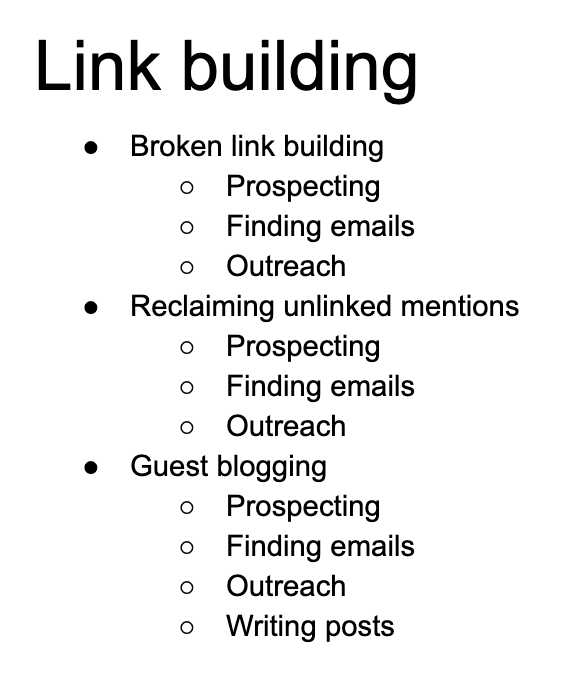
Breaking things down into tasks and subtasks in Google Docs.
Once you’ve done that, create SOPs for each subtask.
How? Just run through each step yourself and document the process in detail. If you were creating an SOP for unlinked mention prospecting in Ahrefs, it might look like this:
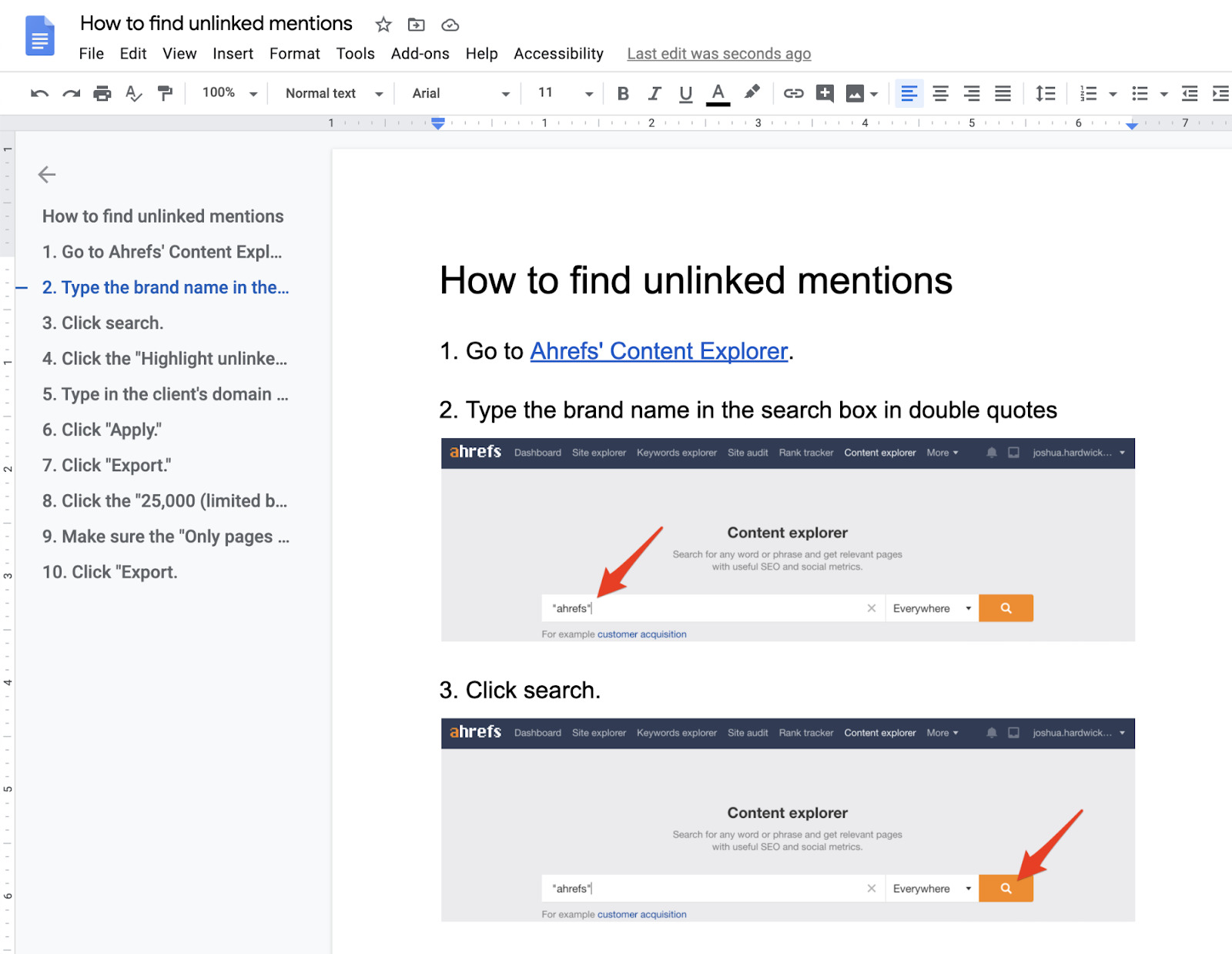
Whether you do this in writing or on video is up to you. Just don’t assume that people you hire know your expectations or have SEO experience. Always outline every last detail to the point of visualization.
If you want to get things done faster, record videos and hire someone to convert them into written SOPs.
Keep track of everything by linking to SOPs from your doc.
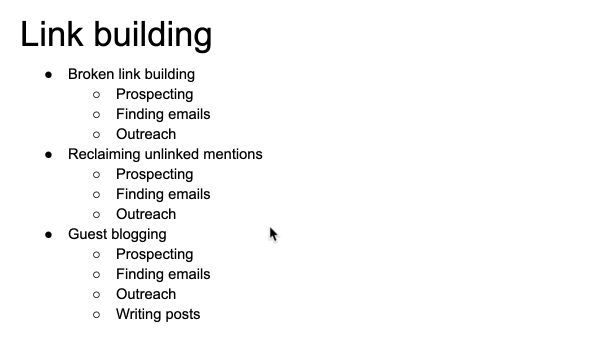
Step 2. Hire freelancers
Most people try to hire one freelancer to do everything. That’s a mistake because different tasks require different skills, and it’s common for the quality of someone’s work to deteriorate if you spread them too thin.
For that reason, it’s better to group tasks by skillset and hire multiple people based on that.
For example, although we’ve broken down link building into different tactics, there’s a lot of similarity in their subtasks. It’s clear that we probably need one person for prospecting, another to find contact information, another to send outreach emails, and another to write the occasional guest post.
Let’s visually group these by color.
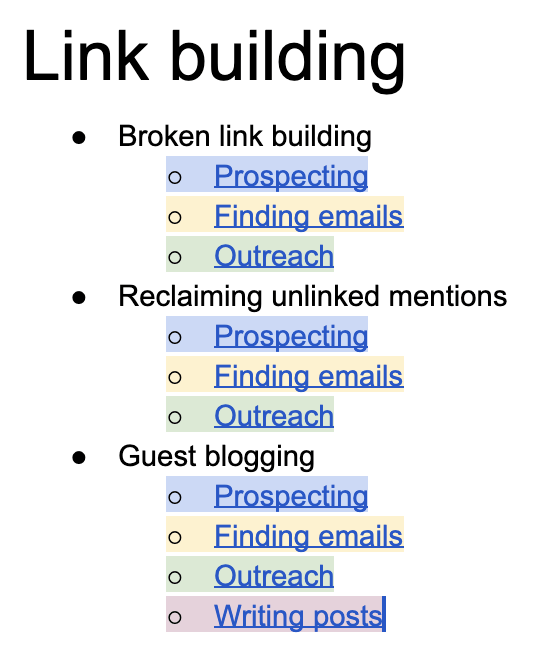
Note that if you’re looking to outsource things fully, you’ll need someone to manage all of this and keep freelancers on track. However, if you’re new to outsourcing, I’d recommend taking on the position of manager yourself to start. You can begin outsourcing once you get a better sense of what each facet of management involves.
Either way, the process from hereon is the same:
First, take each group of tasks and think about the skills and experience required. It’s best to group these into “need to have” and “nice to have” skills.
For example, here’s what that might look like for an outreach executive:
- Need to have:
- Good written communication skills
- Good people skills
- Good organizational skills
- Proficiency with Google Docs/Sheets
- Fast typer
- Nice to have:
- Experience with Pitchbox
- Basic understanding of what outreach entails from an SEO perspective
- Experience doing outreach for SEO
Second, create job listings from these descriptions on a freelancing site like UpWork and begin hiring people.
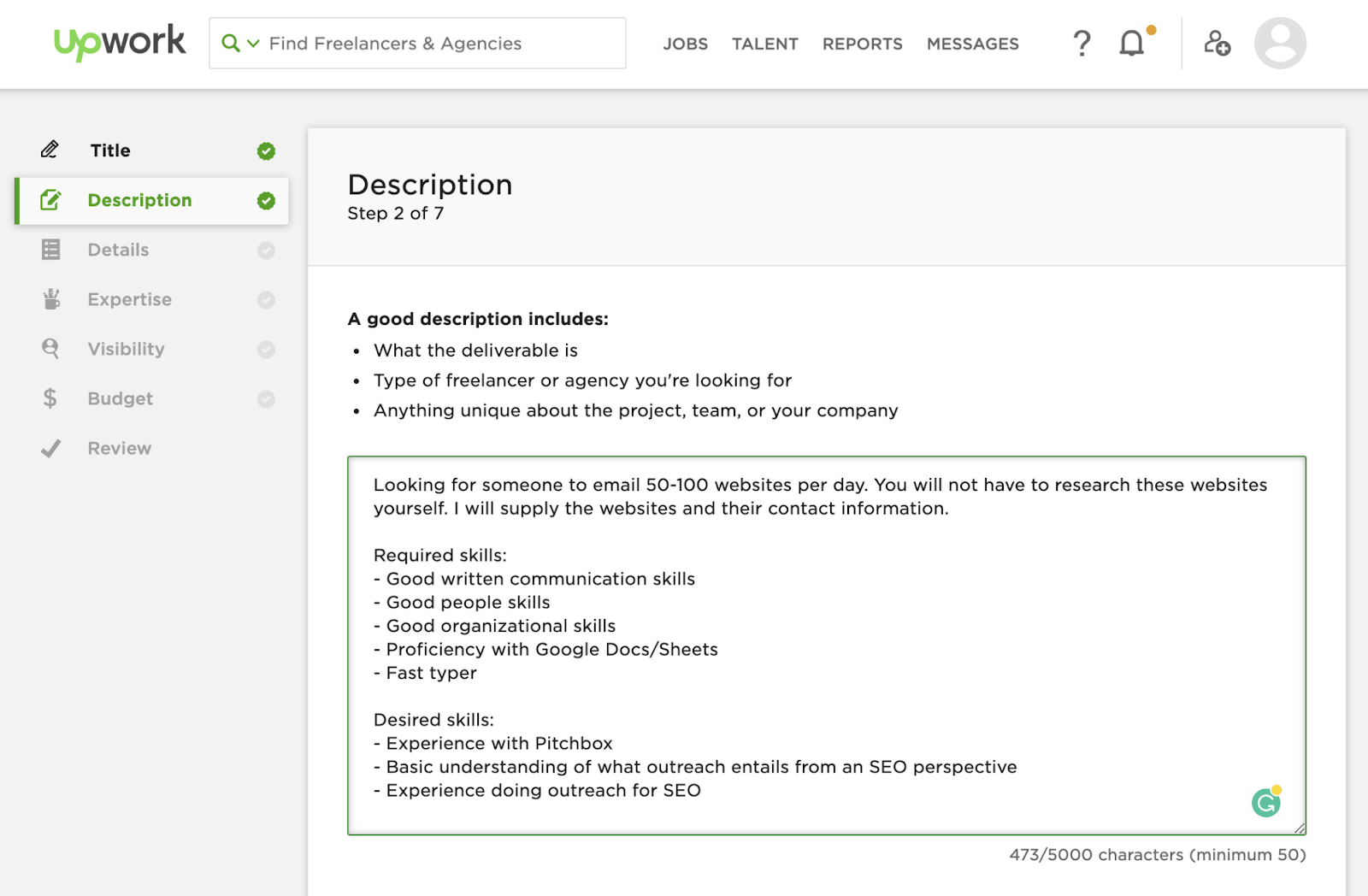
Is this as straightforward as it sounds?
Not at all. The hiring process could be a whole other blog post in itself, and for that reason, I won’t go into too much detail here. But I will leave you with a few essential tips:
- Start with paid tasks. If someone sounds promising, don’t just take their word for it. Hire them for a paid one-off task and assess their work. Most people talk the talk but don’t walk the walk, so this is a necessary first step.
- Hire candidates for a trial period. If the freelancer still seems promising after the first task, hire them for a limited period and see how they do. Just be prepared for a frustrating level of flakiness. If someone’s car breaks down three times in one week, they’re probably not going to be the best long-term hire.
- Hire fast, fire fast. It’s extremely unlikely that your first hire will turn out to be the right fit for your business, so don’t stick with them if it’s not working out. There’s no point dragging out a relationship that isn’t working. It’s better for everyone if you call it quits as soon as you realize it’s not working out.
Step 3. Manage and refine
Even if you’re only outsourcing one facet of SEO like link building, it’s still a complicated business with lots of moving parts. And that’s why you need a project management tool to keep track of everything.
There are plenty of these around, but I recommend opting for one with kanban boards like Trello. You can use these to create a visual production line for each task.
Here’s what that might look like for one of our link building tactics:

You can see that the first column is for SOPs. That’s to make it easier for freelancers to find the instructions they need fast. The other columns are subtasks. The idea here is that whenever you start a new campaign, the manager creates a card in the first column and tags the person responsible for the task.
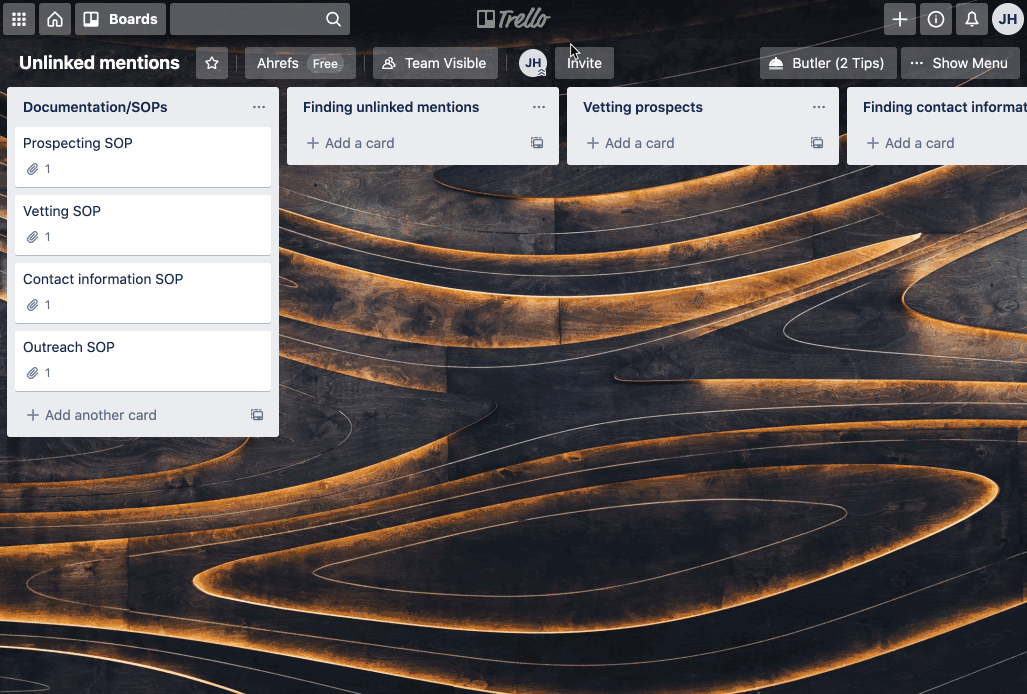
That person will then be responsible for moving it to the next column once complete and tagging the right person to keep things moving.

The best way to ensure a smooth workflow here is to include that as the last instruction in your SOPs.

Now, it’s important to realize that there are some downsides to creating such an efficient system, one of which is a feeling amongst freelancers of being ‘just another cog in the machine.’ You can combat that by making an effort to chat with them regularly and making sure they know they’re a valued member of the team.
That doesn’t necessarily mean asking them what they did over the weekend or what they’re having for dinner, but more things like:
- Is there anything in your work I can clarify?
- Have you run into any roadblocks this week?
- How are you working with other team members?
You’ll probably be surprised at some of the answers they give you. Sometimes you’ll realize they’ve had the wrong understanding of their task the entire time, whereas other times, they might suggest ways to improve your processes.
If that happens, don’t hesitate to adjust your SOPs. That’s a fantastic way to gradually improve them over time and make everyone in your organization more efficient.
You should also keep a close eye on your day to day tasks. There’s a common saying that you should never do the same thing twice. If you find yourself repeating something over and over, then it’s obviously a task that can be systemized and outsourced.
Final thoughts
Everything above is just one way to outsource SEO. There are no doubt plenty of people outsourcing things successfully with a completely different framework, and that’s fine. Your job as a business owner is to find the framework that works for you, put it into practice, and continually refine things over time.
Got questions or suggestions? Give me a shout on Twitter.
